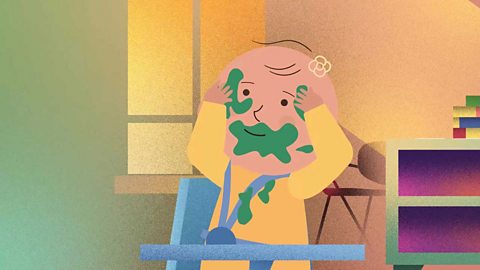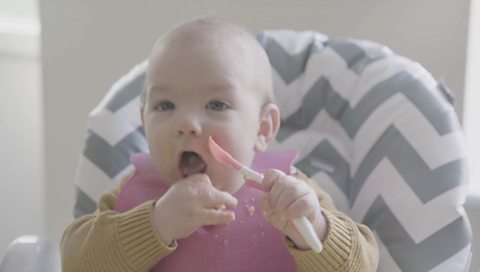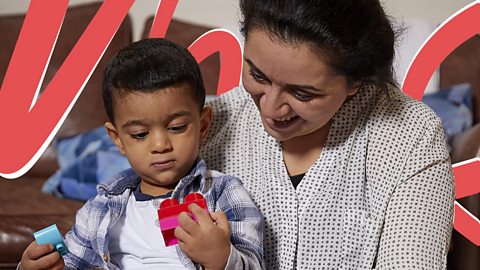Ever noticed that your baby is obsessed with putting things in their mouth? The reasons might surprise you… Here’s all you need to know about the benefits of baby mouthing, and how to keep your little one safe.
Dr Marina Bazhydai, a Developmental Psychologist from Lancaster University’s Babylab and Active Learning Lab says: “Babies need to learn about virtually everything in this world when they are born, so they learn as they grow with whatever tools they have. Using their mouths to explore the world around them is a totally normal part of their development.
Mouthing lets them take in information about objects and their own bodies. The texture, the taste, the shape, the size - it’s a great way for them to satisfy their curiosity and learn.”
Babies are really great at putting things in their mouths.
Their tongue's so amazingly sensitive, it's telling them lots about what an object feels like, plus, of course, the taste!
What a sensation!
It might drive us mad with worry half the time, but it's a really important way for them to explore their world.
So, when they start showing an interest in solids, get them to try lots of different sorts of food, you'll soon find out what they like.
And did you know that what they like can be strongly affected by what mum ate while you were in the womb and if they were breastfed?
Generally, babies tend to prefer sweet tastes and smells, but encourage them to try all different flavours.
The more foods they experience at an early age, the more likely they are to have a varied diet later in life.
Maybe not all different flavours…
When does baby mouthing start?
It actually starts in the womb, bringing their hand to their mouths and sucking their thumb, says Dr Bazhydai.
“After birth, babies will start putting things in their mouths from around 3 months, and it can go on for a few years. Every moment of their life gives them so much information and baby mouthing is a big part of making sense of that.”
Speech and language therapist Janet Cooper agrees, saying: “Before their hands and fingers can hold and squeeze things properly, their mouth is the most sensory place and has the most nerve endings, making it a very useful tool for exploring.
Give your baby a range of textures to explore. If you are giving them a big metal spoon to play with, they are going to mouth a different texture than if they’ve got a plastic purpose-made toy.
It can help with first words
As your baby happily chews on their favourite blanket or toy, they’re also learning about making new sounds. And with baby babbling usually starting when babies are around 4-6 months old, this mouthing is important.
Scientists recorded babies playing with toys and putting them in their mouths. They found babies made more noises and different sounds like ‘kuh’, ‘duh’ and ‘buh’ when they had a toy.
"Your mouth has got the most sensation in your body, particularly around your lips, the front of your mouth and an area just behind your top teeth called your alveolar ridge where we make a lot of sounds," explains Janet.
In the English language, the ‘T’, ‘D’, ‘N’ and ‘S’ sounds are all made on that alveolar ridge. By putting objects in their mouth it helps move a baby’s tongue around. And this then helps them make - and practice - new sounds that they might not have been able to make before.

Image caption, Babies' tongues are super sensitive to different tastes and textures.
1 of 6
It boosts their immune system
From a dusty picture book to a teddy they’ve dropped on the floor, baby mouthing has another surprising (but slightly gross) benefit: it introduces new germs to your baby’s body. This is really helpful in building up their immune system.
"By putting things in their mouths, babies are introducing new germs and their body then makes antibodies to fight that bacteria”, says Janet. Just be careful if you’re somewhere with more germs (your GP surgery or local soft play for example) or if your baby drops whatever they are exploring onto a dirty surface.
It prepares them for weaning
When your child is around 6 months, they may be ready for their first taste of solid food. But first, they’ll need to be able to coordinate their eyes, hands and mouth so they can look at something, pick it up and put it in their mouth. Luckily, they’ve been practicing this skill for a while!
Baby mouthing helps your baby start to explore all their motor movements and this prepares them for weaning. The link between mouth and hand movements is crucial for this, says Janet.
It helps with teething (and self-soothing)
Baby mouthing usually peaks when babies are around 6 or 7 months old when everything seems to end up in their mouths. And this is also when teething starts.
“Mouthing can help them cope with the discomfort of teething”, says Dr Bazhydai.
Additionally, it helps them learn about self-soothing: the idea that if you're uncomfortable, you try and make things better by putting something in your mouth or sucking your fingers.

Baby mouthing: staying safe
Your baby has no idea what is safe and what isn’t, so make sure whatever they put in their mouth isn’t dangerous. While babies have sensitive gag reflexes, small toys (or parts of toys) could cause them to choke.
“Everything will go in their mouth”, says Dr Bazhydai. “And while it’s a positive thing, parents and carers need to be sure what they are mouthing is safe.”
Here are some safety tips to follow:
Keep things that contain batteries, including button batteries, out of the way. If you think your child has swallowed a battery, call 999 or take them straight to A&E.
Make sure your baby's toys have the British Standard kitemark, lion mark or CE mark. This proves the toy meets safety standards.
Always follow the age warnings on a toy. If it’s labelled “Not suitable for children under 36 months”, keep it away from your baby or toddler under the age of 3.
Check toys for any sharp edges or small parts that could be swallowed if they break off.
Your baby will explore anything with their mouths, including bottles. Keep any toxic products like cleaning sprays and bleach well out of reach.







